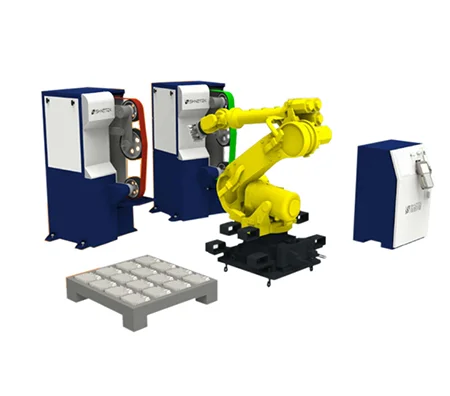In today's era of high-precision manufacturing, components are increasingly complex, tolerances are becoming tighter, and expectations for surface quality are more stringent than ever. No matter how accurate the machining or forming process is, unwanted burrs—tiny metal projections or jagged edges—are often left on a part's surface. These burrs can compromise the function, safety, and assembly compatibility of parts. Traditional manual deburring processes involve skilled laborers using files, grinders, or abrasive pads to remove burrs. However, this approach introduces significant variability, inconsistency, and safety concerns. As production volumes rise and part complexity increases, manual deburring becomes a major bottleneck in the manufacturing line. Enter the robotic deburring machine—an advanced, automated system that leverages robotic arms and specialized tools to deliver precise, repeatable, and high-speed deburring. This technology has transformed how industries approach surface finishing, offering significant improvements in productivity, quality, and safety.
What is a Robotic Deburring Machine?

A robotic deburring machine is an automated workstation that utilizes an industrial robotic arm equipped with abrasive tools to remove burrs and sharp edges from workpieces. These machines are integrated with sensors, vision systems, force-control modules, and intelligent software to ensure consistent and high-quality results across a wide range of parts and materials.
The system is designed to adapt to various shapes and contours of metal, plastic, or composite components. Unlike fixed-tool CNC deburring machines, robotic systems provide greater flexibility in motion, orientation, and access—making them suitable for both simple and highly intricate part geometries.
In most cases, the robotic deburring machine is embedded into a larger production ecosystem, working in coordination with conveyors, CNC machines, quality inspection stations, and even packaging lines. This enables end-to-end automation and real-time quality control.
Moreover, the system's programmability allows manufacturers to adjust deburring paths, tooling pressure, and spindle speed based on the material, part design, and desired surface finish—factors that are critical in achieving reliable performance across different product lines.
Performance Advantages of Robotic Deburring Machines
A robotic deburring machine offers a host of performance advantages that traditional deburring methods—whether manual or semi-automated—simply cannot match. By integrating cutting-edge robotic control, precision tooling, and intelligent software, these machines drive efficiency and quality across every dimension of modern manufacturing. Below, we explore the most impactful benefits of deploying a robotic deburring machine in industrial applications.
Unmatched Consistency and Repeatability
One of the defining benefits of a robotic deburring machine is its ability to deliver unmatched consistency. In manual deburring, the outcome often varies depending on the operator's skill level, fatigue, attention to detail, and technique. Even slight deviations can result in burrs remaining, excessive material removal, or inconsistent surface finishes.
A robotic deburring machine, in contrast, executes pre-programmed tool paths with precisely controlled feed rates, spindle speeds, and applied forces. Every movement is calculated, repeatable, and unaffected by external variables such as shift changes or human fatigue. Whether it is the first component of the day or the last part in a long production run, the machine delivers identical quality, ensuring every part meets exact dimensional and aesthetic specifications. This reliability is particularly crucial in industries where uniformity is non-negotiable—such as aerospace, medical device manufacturing, and automotive production.
Higher Throughput and Cycle Time Reduction
Speed and efficiency are paramount in competitive manufacturing environments. A robotic deburring machine significantly outperforms manual operations when it comes to throughput. Unlike human workers who require rest periods and are limited by physical endurance, robots can operate continuously, 24/7, without sacrificing quality.
These systems can be programmed to process multiple parts simultaneously or in rapid succession. Additionally, many robotic deburring machines support automated tool changers and part repositioning capabilities, reducing downtime between cycles. As a result, total cycle time per part is dramatically reduced. When scaled across high-volume production, this time savings translates to major operational efficiencies and faster order fulfillment. The ability to achieve higher throughput without compromising surface finish quality makes the robotic deburring machine a strategic asset in any lean or just-in-time manufacturing system.
Lower Labor and Operational Costs
Although a robotic deburring machine requires a higher upfront investment compared to manual equipment, it delivers significant cost savings over its operational lifetime. First, it reduces the need for a large team of skilled operators. A single robotic system can perform the work of several manual deburring stations, effectively consolidating labor and reducing payroll costs.
Moreover, robotic systems minimize the need for rework and scrap by achieving consistent quality. Fewer defective parts translate to higher yield and less material waste—critical factors in maintaining profitability. Operating costs are also reduced through the optimization of consumables; the system can monitor tool wear and only replace tools when needed, avoiding premature changes. On top of that, many robotic deburring machines are integrated with energy-efficient drives and motors, lowering overall power consumption.
Injury-related costs are another overlooked expense that robotic systems help mitigate. Manual deburring exposes workers to sharp parts, repetitive strain, and metal dust—all of which can lead to costly health claims. By automating this hazardous process, companies reduce medical expenses, insurance premiums, and employee turnover.
Process Flexibility and Tooling Versatility
Modern manufacturing demands flexibility—whether it's producing a range of part geometries, shifting between small and large batch sizes, or dealing with complex materials. A robotic deburring machine excels in environments that require adaptability. These systems can be easily reprogrammed to handle different workpieces, whether they are made of aluminum, stainless steel, titanium, or plastic composites.
Quick-change tooling systems allow the robotic arm to automatically switch between different deburring tools—such as brushes, grinders, or abrasive belts—depending on the part's requirements. Some advanced systems also use multi-functional end effectors that can adjust tool orientation, pressure, and rotation speed in real-time. This versatility makes robotic deburring machines especially valuable in industries such as aerospace or contract manufacturing, where product variation is common.
With offline programming capabilities, engineers can create, simulate, and optimize deburring paths for new parts without interrupting production. This enables faster transitions between product runs and reduces the time and cost associated with setup and commissioning. Ultimately, the flexibility of a robotic deburring machine empowers manufacturers to respond quickly to market demands and customer requirements without investing in separate equipment for each part type.
Enhanced Workplace Safety
Deburring is a process associated with multiple safety hazards: sharp burrs can cause lacerations, metal dust can damage lungs, and constant vibration can lead to long-term musculoskeletal injuries. Traditional methods often expose workers to these risks daily. However, the adoption of a robotic deburring machine greatly improves the overall safety and ergonomics of the production environment.
Robotic systems are typically enclosed within protective safety cages or collaborative safety zones, limiting human exposure to the actual deburring process. Many setups also include integrated dust extraction units and vacuum systems to control airborne particles and maintain air quality. Noise levels are reduced through acoustic enclosures and quieter tool operation, creating a more comfortable workplace.
In applications where human involvement is required—such as loading and unloading parts—safety interlocks and emergency stop features ensure worker protection. Some systems also employ collaborative robots (cobots) that can safely work side-by-side with humans, thanks to built-in force and proximity sensors.
From a compliance perspective, robotic deburring machines help manufacturers meet occupational safety standards such as OSHA, CE, or ISO 45001. By reducing workplace injuries and associated liabilities, these machines contribute to a more sustainable and socially responsible manufacturing operation.
The robotic deburring machine has emerged as a game-changing solution for manufacturers seeking to improve quality, reduce costs, and increase automation. It not only replaces manual labor but elevates the entire deburring process to a new level of precision, safety, and adaptability. By investing in robotic deburring, companies gain a competitive edge—delivering better products, faster turnaround times, and consistent performance across high-mix production environments. Whether you're producing intricate aerospace components or heavy-duty industrial castings, robotic deburring machines ensure that your surface finishing processes are as advanced as the products they serve.
https://www.shinetekgrind.com/Robotic-Grinding-System-Robotic-Grinding-Deburring-Machine.html
www.shinetekgrind.com
Suzhou Shinetek Grinding Technology Co., Ltd.


